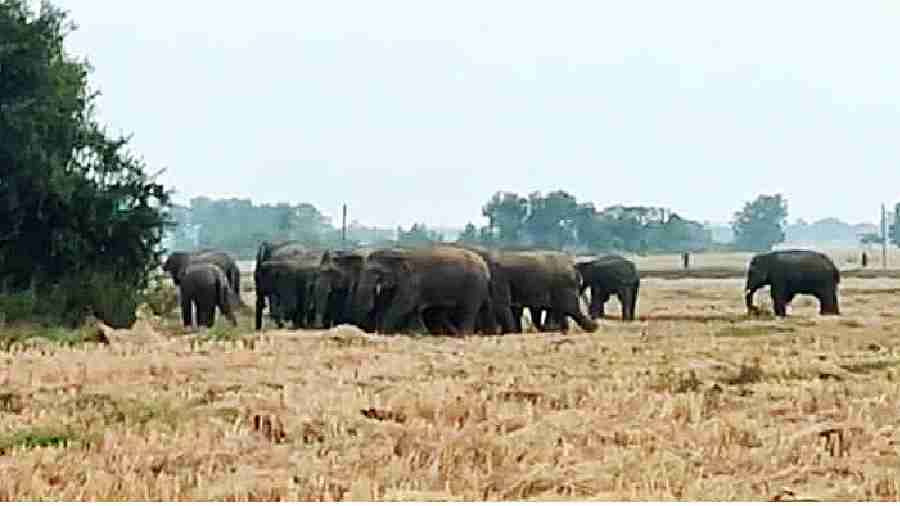Three elephants identified as “troublemakers” have been relocated from the forests of south Bengal in the past few months and at least seven more are on the list, forest department officials said.
The department has identified several elephants, all tuskers and loners, which officials said were responsible for the majority of deaths in the forests of south Bengal in 2022-23, the officials said. The Centre has allowed the relocation of 10 such jumbos.
But some wildlife scientists said relocation of an elephant to a newer habitat has a limited chance of success. If the elephant creates trouble even after relocation, it is ideal to re-dart it and keep it captive, said a researcher.
“We have identified the elephants as rogues. We had sought permission from the Union ministry of environment, forests and climate change to tranquilise, collar and relocate these elephants. We have received permission to relocate 10, out of which, three have already been dealt with. Seven more are under watch,” said an official in the state forest department.
Since elephant is a Scheduled I animal and accorded maximum protection under the Wildlife Protection Act, 1972, a permission from the Centre is mandatory before capture and relocation of the animal.
Two of the elephants have been sent to Buxa Tiger Reserve in Alipurduar, where the forests are bigger, and more habitable for elephants, than those in south Bengal, said officials.
On Friday, one elephant was darted in Purba Bardhaman district and sent to a forest in Jhargram.
The human-elephant conflict in West Bengal has aggravated this year. At least 85 people have been killed by elephants in West Bengal so far in 2022-23, said a forest official. In 2021-22, the number was around 75 and in 2020-21, around 115, the official said.
The chief wildlife warden of the state, who is the authorised spokesperson for the department, did not take calls. Neither did he respond to messages. Most other officials remained tight-lipped.
In Jhargram district alone, 19 deaths were reported between April and September last year, said an official.
Raman Sukumar, a professor at the Indian Institute of Science in Bangalore who has studied elephant movement for decades, said relocation was unlikely to be fruitful in the long run.
“Unless you do it a few times, you don’t know if it actually works. The problem is that nobody has systematically studied this except in Sri Lanka. They have done a lot of relocations.
They are saying that by and large, it is a failure. Because the elephants tend to come back to their original area. Especially with males, it does not work at all,” said Sukumar, who has assisted multiple states, including West Bengal, in mitigating human-elephant conflict.
t as soon as the (relocated) elephant comes into a serious conflict situation, be prepared to recapture it and keep it in captivity.”
An official in the West Bengal forest department did not rule out the possibility of keeping rogue elephants in captivity. “If need be, we can keep them captive and even train them to be used as kumkis (trained captive elephant),” said the official.
Of the two elephants sent to Buxa, one was captured in Jhargram and relocated in October. The other tusker, which had strayed to Hooghly, was relocated in February.
The first elephant kept moving and is in Meghalaya, according to foresters who are tracking it from the signals emitted by the collar the jumbo was fitted with. The elephant went via Assam, crossing the mighty Brahmaputra.
The other elephant, sent to the northwestern part of Buxa, is now on the southeastern edge of the park, officials said.
The elephant sent to Jhargram has crossed over to Jharkhand, said an official.
“The so-called rogue elephants are basically young bulls trying to find new territories. In order to prevent deaths, it is important to understand the circumstances of human deaths. Know the trend and then devise solutions. Otherwise, you will come up with knee-jerk reactions,” said Aritra Kshettry, wildlife ecologist and director of Coexistence Consortium, a global network of scientists trying to better understand and enable coexistence between humans and wildlife.
Soumitra Dasgupta, principal chief conservator of forest and head of forest force in West Bengal, said the forest department was doing its best to mitigate the conflict.
“Relocating the elephant in October has produced tangible results. We have adopted a multi-layered approach. There are some steps that are being implemented for quick results on the ground. Some projects are futuristic and will yield long-term dividends,” he said.
